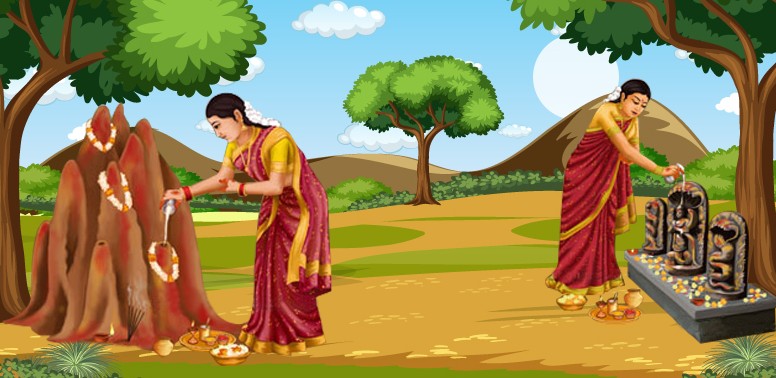

KATHMANDU: As the monsoon clouds gather and the month of Shravan arrives Nepali homes and communities prepare for one of the oldest and most meaningful festivals Nag Panchami.
This day celebrated on the fifth day of the bright half of Shravan is dedicated to worshipping the serpent gods known as Nagas. It is a festival that has been observed for centuries rooted deeply in the culture and beliefs of the Nepali people.
Nag Panchami is not just a religious occasion it is a reminder of how closely humans are connected to nature and how respecting that relationship is essential for life and prosperity.
The festival has special importance because it comes during the monsoon season a time when water is precious and life depends on the rains.
In a country where agriculture is a way of life for many the arrival of rain means hope for a good harvest and survival. The Nagas or serpent gods are believed to control the rain and protect the earth from harm. People worship them to seek their blessings for health safety from snake bites and plentiful rainfall. The festival brings communities together to perform rituals that honor these ancient deities blending faith tradition and environmental awareness.
Ancient Legends and the Meaning Behind Nag Panchami
The story of Nag Panchami is told through many legends passed down from generation to generation. One famous tale comes from the Hindu epic Mahabharata. It tells of King Janamejaya who wanted to take revenge for the death of his father King Parikshit who was bitten by the serpent Takshak. Janamejaya started a powerful snake sacrifice to destroy all serpents.
The ritual grew so strong it threatened the survival of all snakes. To stop this a young boy named Astika son of the serpent goddess Manasa came to the king and convinced him to end the sacrifice on the fifth day of the bright half of Shravan. Since then that day has been celebrated as Nag Panchami to honor snakes and protect them.
In Nepali folklore there is also a story of how the serpent gods stopped the rain from falling over the country causing drought and hardship. A tantric king used his spiritual powers to speak with the Nagas and persuaded them to bring the rains back. To remember this event and honor the power of the Nagas people started the tradition of Nag Panchami. This shows the important role Nagas play in the balance of nature and life.
Rituals and Deep Connection to Nepali Culture
Nag Panchami rituals are deeply intertwined with Nepali culture and daily life especially in rural areas where farming and nature play a central role. On this day families clean their homes and prepare special spaces for worship. Pictures or idols of snakes are placed above doors or in courtyards as a sign of protection and blessing.
These pictures are often made from rice flour cow dung and vermilion reflecting the use of natural sacred materials in Nepali traditions. Offerings of milk play a vital role in the worship.
Since snakes are rarely seen people offer a white paste made from rice flour to symbolize milk. In many villages real milk honey and food like barley and sesame are placed near snake holes or ponds believed to be homes of the Nagas. These offerings are meant to please the serpent gods and seek their blessings for protection health and rain.
Women especially take charge of preparing the offerings and performing the puja. Many devotees observe fasting and spend the day in prayer asking the Nagas to protect their families from snake bites and to bless their crops with good rain. These rituals also reflect the respect for nature which is a strong value in Nepali culture. The festival reminds people of their dependence on natural forces and the need to live in harmony with the environment.
Sacred Places and Community Celebration
Nag Panchami is celebrated not only in homes but also in many sacred places across Nepal. In the Kathmandu Valley ponds like Nagpokhari Taudaha and Nagdaha hold special significance. These water bodies are believed to be the abodes of powerful serpent gods. Thousands of people visit these ponds to offer milk flowers and prayers.
Large gatherings and community pujas take place at these sites strengthening social bonds and cultural identity. The valley’s four Narayan temples also receive many visitors on this day linking the worship of Lord Vishnu with the serpent gods. These places become centers of devotion and celebration where faith and culture come alive.
Cultural Importance and Social Role of Nag Panchami
Nag Panchami plays a crucial role in preserving Nepali cultural identity and strengthening social unity. It brings families and communities together to share rituals stories and celebrations.
The festival passes on important traditions and values from one generation to the next. It also educates younger people about the sacred connection between humans and nature.
In agricultural societies the festival is especially important because it highlights the dependence on rain and fertile soil. The offerings and prayers are expressions of gratitude and hope. Cultural programs such as traditional dances with masks of demons and snakes keep the folklore alive and make the festival vibrant and meaningful for all ages.
Nag Panchami is a reminder of the balance between fear and respect for nature. It teaches that every creature has a place and a role in the cycle of life.
Nag Panchami in Modern Nepal
Despite urbanization and changing lifestyles Nag Panchami remains widely observed throughout Nepal. Even in cities people continue to honor the serpent gods placing images above doors and performing rituals.
The festival’s message of harmony with nature and respect for life remains relevant today especially as Nepal faces environmental challenges.
Nag Panchami encourages people to remember that protecting nature is protecting themselves. As the rains fall during Shravan the festival connects people to their heritage and to the natural world sustaining life around them.